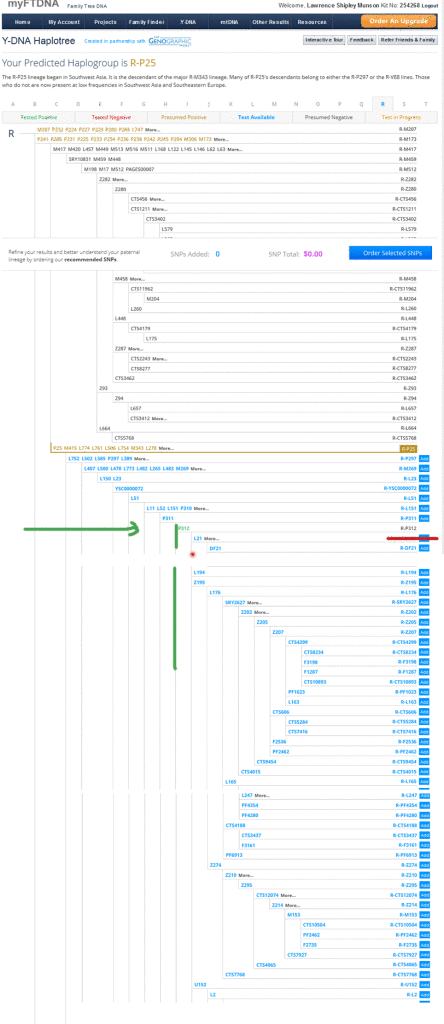 The new Y tree released this past week by Family Tree DNA has dropped all those horrible long names like R1b1b1a1 and replaced them with the main Y haplogroup followed by the terminal SNP. This had long been suggested as a better nomenclature. The downside is that you have to look at a chart to see how an R-P311 might be related to an R-P312 but it is worth it for the simplification of the name. Although I think we R1b’s are used to being different from the R1a’s and I would prefer that we were R1b-P312
The new Y tree released this past week by Family Tree DNA has dropped all those horrible long names like R1b1b1a1 and replaced them with the main Y haplogroup followed by the terminal SNP. This had long been suggested as a better nomenclature. The downside is that you have to look at a chart to see how an R-P311 might be related to an R-P312 but it is worth it for the simplification of the name. Although I think we R1b’s are used to being different from the R1a’s and I would prefer that we were R1b-P312
The new Y tree combines the research of Family Tree DNA and the Genographic project. The press release and its highlights are published on Emily Aulicino’s blog:
http://genealem-geneticgenealogy.blogspot.com/2014/04/family-tree-dna-2014-y-dna-haplogroup.html
and Debbie Kennett’s blog goes into deeper details:
http://cruwys.blogspot.com/2014/04/the-new-2014-y-dna-haplotree-has-arrived.html
But what does this mean for us R1b Munsons? Are we Scottish or Germanic? Where did our earliest known paternal line ancestor, Mons Knutson Titland 1665-1725 , who farmed a little north of Bergen, come from? Does our Y DNA tell us?
According to Wikipedia, “The frequency [of the R1b haplogroup] is about 71% in Scotland, 70% in Spain and 60% in France. In south-eastern England the frequency of this clade is about 70%; in parts of the rest of north and western England, Spain, Portugal, Wales and Ireland, it is as high as 90%.” I have seen the hypothesis that something about R1bs makes them likely to have more sons. There seems to be some truth to that in our known family; grandfather: 3 sons, 2 daughters, greatgrandad: 6 sons, 2 daughters; gg-grandad: 4 sons, 1 daughter; ggg-grandad Lars Monsen: 4 sons, 1 daughter; gggg-grandad Mons Olesson: 6 sons, 3 daughters; ggggg-grandad Ole Monssen: 6 sons, 2 daughters; gggggg-grandad Mons Knutson Titland: 4 sons, 2 daughters … of course not all these children lived to maturity and I think I should look at the children of the male children in order to get closer to some statistical significance. But you can see from this pattern how quickly this Y lineage could become quite dominant.
Our STR markers at 67 match a Swede and a Scot. After analyzing the SNPs for our Y at 23andme, we tested a few more SNPs at family tree DNA: DF100 (negative) and next P312 (positive). However P312 is a large group even though we know we are negative for two of the major subclades: U152- and L21-. On the new chart I do not see DF27 which was the next SNP on the R1b project diagram, but I do see L194 and Z195 as possibilities … and also L152. So now to check if 23andme tested any of those.
It looks like the best approach is to convince one of the many Munson men to take the latest Genographic project test in order to discover which of the many downstream SNPs from P312 we have and find whether our paternal ancestors came from Scotland or Sweden or …
Roberta Estes has also done a detailed blog post on the new Y tree at http://dna-explained.com/2014/05/09/2014-y-tree-released-by-family-tree-dna/
I was discussing possible tests for my maternal uncle, who is also Norwegian, L21-. U152-, R1b-P312+, with ISOGG R1b expert, David Reynolds, at last year’s SCGS Jamboree DNA day. He said that the Geno 2.0 was great for R1b-L21+, but probably not helpful for L21 negative R1b-P312.
Then again, the R1b-P312 Project recently place my uncle in its ‘P312+ DF19? (R1b>P312) (Please order DF19 or Big Y or Geno 2)’ grouping. Maybe the Geno 2.0 would be okay, but if the haplogroup project admins can predict probable SNPs to test for, that might be a less expensive way to go.
Thank you Steve that is extremely helpful. I will follow your advice
I just checked. DF27 is available at FTDNA, by clicking on the ‘advanced SNP order form’ link, on the bottom of the Haplotree page.
Bonjour,
J’ai appris ma confirmation RP 312 ce jour. RP 312 mtDNA V (je suis Francais, de la Region Aquitaine du departement de la Gironde . Cordialement Alain Monier
Bonjour mon cousin! environ 70 % de l’Europe occidentale ..
lire ce ici: http://en.wikipedia.org/wiki/Haplogroup_R1b_%28Y-DNA%29#R1b1a2_.28R-M269.29
et ici:
http://www.eupedia.com/europe/Haplogroup_R1b_Y-DNA.shtml